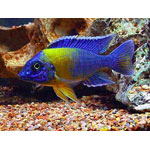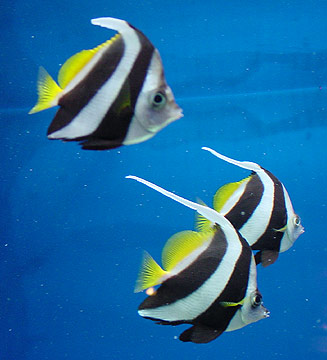Maulana

|
Scientific Name: Aulonocara stuartgranti Price: Upon Request Origin: Lake Malawi Family: Cichlidae (Cichlids) , subfamily: Pseudocrenilabrinae NOT AVAILABLE NOW |
|
Other Names: Maulana Bicolor Peacock, Maulana Bi-Color 500, Aulonocara Maulana, |
|
Technical Info
Temperature: 21 - 28 ℃
pH: 8 - 8.5
GH: 12 - 22
Max size: 12 cm
Min Tank size: 200 Ltr
Position in Aqua: No special swimming level
Description
The body of the male Maulana is blue with darker vertical bars. There is a wide band of yellow just behind the head that extends into the pectoral fins and there is some yellow in the tail as well. The dorsal, anal, and pectoral fins are edged in white. The females are quite drab, a maroonish color with no apparent (or very slightly apparent) darker verical bars.
Food
Aulonocara maulana will accept quality flakes and pellets. Treats of brine shrimp, daphnia and mysis should also be offered.
Breeding
Mouth-brooder. The female will protect a batch of 4-25 fry in her mouth for up to 4 weeks. The females will not eat will they brood. You can tell if a female is brooding by her enlarged mouth. Fry accepts all kinds of food. Brooding females are isolated for more productive breeding. It is recommendable to try to make the isolation as short as possible to avoid that the females loses their social status which may cause fights once they are returned.
Compatible with
This fish is best kept with their own kind as they are much more peaceful than other Malawi cichlids. If in a tank with mates that are unsuitable, they may be eaten (esp. the small females!) or will not get enough to eat. Mbunas are not good tankmates for the Maulana. Try to not house with other Aulonocaras to prevent hybridization. Can be kept with Utakas that are similar in size, but avoid female Utakas that are similar in appearance to the Aulonocaras as they will cross breed. You can use dither fish such as Rainbowfish (Melanotaenia sp.) and/or Congo Tetras (Phenacogrammus interruptus) because sometimes they can be very shy fish.
Note
Not only do males develop their coloration and finnage over time, but coloration and finnage are especially variable among peacock males. In any given group that includes a number of specimens, there are likely to be a few extraordinary ("show") males, a larger number of above average specimens, and a larger number of average specimens. The average and above average groups can be encouraged to display better coloration by making them dominant within their aquarium and providing them with female companions. The aquarist should also be aware that immature peacocks are among the most drably colored of all aquarium

